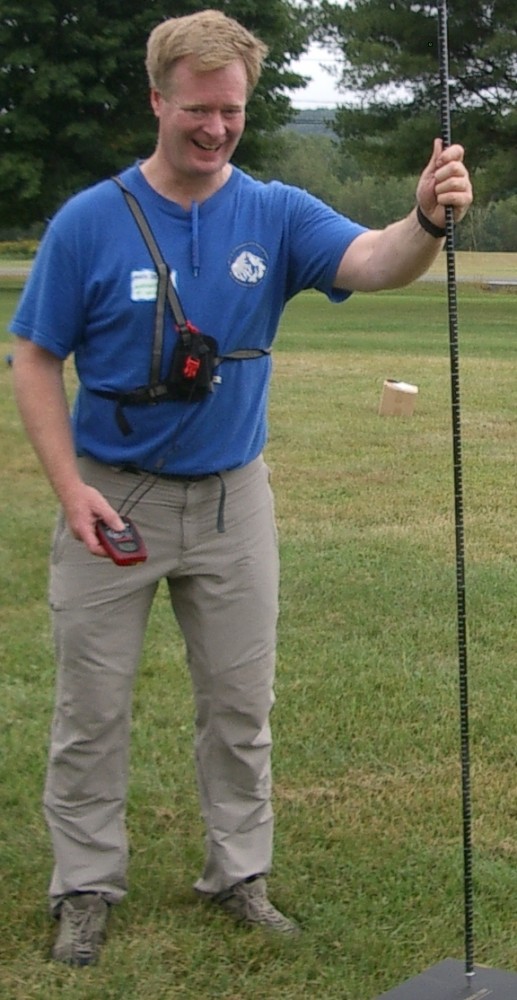In 2003, Pieps introduced its DSP avalanche beacon, the first beacon to offer either a third antenna (to eliminate nulls and spikes in the final search phase) or marking/masking/flagging (to allow a focus on just one beacon at a time in a multiple-burial scenario). Now on its sixth major firmware iteration, Pieps has improved the DSP significantly over the years.

Mark Renson, from the Mad River Glen and Mt Washington ski patrols, finds a “victim” with a Pieps iProbe during the September 2008 National Ski Patrol refresher at Northfield, MA.
Pieps has also recently introduced three other innovative avalanche-related electronics items. First up was the iProbe. As an NSP and AIARE avalanche instructor, whenever students ask how they’ll know when a probe strike hits the buried victim (as opposed to the ground, or some brush), the standard response is supposed to be, “you’ll know!” But with the iProbe, your probe will tell you. How so? Appearing as just another thick-diameter carbon fiber probe with a curiously enlarged handle, the iProbe contains a small search-only beacon in its tip. The iProbe will start beeping within about two meters of the victim and then emit a continuous beep within about half a meter.
But wait, there’s more! If the victim has a Pieps DSP or Freeride, the iProbe can mask that victim’s signal for all searchers. By contrast, a signal separation beacon – like the Pieps DSP, Ortovox S1,or Barryvox Pulse — will mask any victim’s signal, but only for that searcher’s beacon. Any other searchers in a close-proximity multiple burial will still have to contend with the potential confusion of that first victim’s signal while searching for any other burial(s). The iProbe though can suppress the DSP’s or Freeride’s transmission. (This makes the standard practice of leaving the probe in place after a successful strike even more important – think about it…)
Available originally last season (i.e., Fall 2008) only in the 220cm model, a 260cm model is now also available. Note that the effective lengths of these probes are significantly longer than their mechanical lengths, since the iProbe can “strike” a victim without physical contact. The weight penalty relative to a regular carbon fiber probe is just a few ounces.
Overall, my personal impressions of the iProbe matched up pretty well with the more in-depth review published here last month.
Next up is the Pieps Checker, new for Fall 2009. This is a miniature receive-only beacon is designed for trailhead checks. Other companies are now making beacon checkers designed for backcountry access gates, ski patrol shacks, and other fixed locations. The Checker though is designed to be slipped around your neck with its provided lanyard, then easily packed away. The advantage over using your own beacon for a trailhead check is that the Checker has a shortened range, so that a larger group can be given the okay without having to spread out everyone. (The Ortovox S1 and Barryvox Pulse have this same feature.) Relative to its weight, size, and cost — all pretty much close to negligible – this is a very useful device. Overall, I think anything that makes you more aware of avy safety at the trailhead is a good thing, and if it’s light, small, and provides a check on your rescue devices, so much the better.
And finally, also new for Fall 2009 is the Pieps 30 Plus inclinometer/thermometer. Personally, I’ve previously preferred to use the clinometer function on my compass, since I can sight down a slope. But if you like to lay your ski pole down on a slope, a separate clinometer is a useful device. Previously for our ski patrol avalanche course loaner fleet, we used the Life-Link Slope Meter, whose dial seemed designed to crack upon its very first outing. Recently we acquired a batch of sturdier slope meters from Backcountry Access. Now Pieps has designed a digital clinometer (along with thermometer) that attaches to a ski pole. Once again, relative to its weight (about an ounce) and size (basically nothing when secured to the ski pole), this is a very useful device.
I’ve found that the clinometer adjusts very easily and securely to any diameter ski pole. The power button has a sensible auto-off feature. Angle measurements are accurate and easy to read. Oh, and it also displays the temperature — a press of the single well-sealed button switched between C and F. Overall, although I still plan to sight down major slopes with my compass’s clinometer, but “calibrating” my own brain on a regular basis the Pieps clinometer is super-convenient. Also perfect for snowpit work, both for measuring the angle of the pit and also taking air temperature readings. (No more attempting to balance my snowpit thermometer on top of a ski pole grip and always having it fall down in the snow?) Overall, is this a must-have item? Hardly, but it can help in your slope studying and snowpit assessment, plus I believe that any “fun” safety-related gadgets will help you be more aware of safety.
October 11 Update:
And two new Pieps avy items for this coming 2011-12 season:
— The ~$100 Pieps Backup is a transmit-only beacon, and that furthermore transmits only in the absence of any movement. The concept is that if you’re searching and are then buried in a secondary slide, when your Pieps beacon still in search mode, the Pieps Backup will then kick in. (Note that some competitors essentially incorporate this kind of motion-dependent revert-to-send mode into their beacons.)
— The $150 Pieps TX600 is an off-frequency transmit-only beacon, intended for dogs and gear (e.g., tents, gear stashes). The TX600 can be located only with a Pieps DSP beacon running the very latest 8.2 firmware.
(WildSnow guest blogger Jonathan Shefftz lives with his wife and daughter in Western Massachusetts, where he is a member of the Northfield Mountain and Thunderbolt / Mt Greylock ski patrols. Formerly an NCAA alpine race coach, he has broken free from his prior dependence on mechanized ascension to become far more enamored of self-propelled forms of skiing. He is an AIARE-qualified instructor, NSP avalanche instructor, and contributor to the American Avalanche Association’s The Avalanche Review. When he is not searching out elusive freshies in Southern New England or promoting the NE Rando Race Series, he works as a financial economics consultant.)
WildSnow guest blogger Jonathan Shefftz lives with his wife and daughter in Western Massachusetts, where he is a member of the Northfield Mountain and Thunderbolt (Mt. Greylock) ski patrols. Formerly an NCAA alpine race coach, he has broken free from his prior dependence on mechanized ascension to become far more enamored of self-propelled forms of skiing. He is an AIARE-qualified instructor, NSP avalanche safety instructor, and contributor to the American Avalanche Association’s The Avalanche Review. When he is not searching out elusive freshies in Southern New England, he works as a financial economics consultant.


